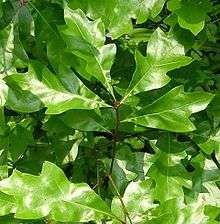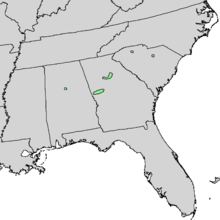Quercus georgiana
| Georgia oak | |
|---|---|
 | |
| Georgia oak leaves | |
| Scientific classification | |
| Kingdom: | Plantae |
| (unranked): | Angiosperms |
| (unranked): | Eudicots |
| (unranked): | Rosids |
| Order: | Fagales |
| Family: | Fagaceae |
| Genus: | Quercus |
| Section: | Lobatae |
| Species: | Q. georgiana |
| Binomial name | |
| Quercus georgiana M.A.Curtis 1849 | |
 | |
| Natural range | |
Quercus georgiana, the Georgia oak or Stone Mountain oak, is a rare deciduous oak. It is native to the southeastern United States, mainly in northern Georgia, but with additional populations in Alabama, North Carolina, and South Carolina.[1] It grows on dry granite and sandstone outcrops of slopes of hills at 50–500 meters (160–1,640 ft) altitude.[2][3]
Quercus georgiana is a small tree, often shrubby, growing to 8–15 meters (26–49 ft) tall. The shiny green leaves are 4–13 cm (1.5–5 in) long and 2–9 cm (1–3.5 in) wide, with a 0.6–2.3 cm (0–1 in) petiole, and five irregular, pointed, bristle-tipped lobes; they are glabrous (hairless), except for small but conspicuous tufts of hairs in the vein axils on the underside. The leaves turn dark red to brown in the autumn, stay on the tree throughout the winter, and fall as the new leaves bud in the spring. The acorns are round, 9–14 mm long, maturing about 18 months after pollination.[3]
The Georgia oak is classified in the red oak section Quercus sect. Lobatae. The tree was first discovered in 1849 at Stone Mountain, Georgia, where several specimens grow along the popular walk-up trail. In the wild they are often shrub-like.
It is occasionally cultivated as a specimen or garden tree in USDA plant hardiness zones 5-8. Besides landscape horticulture, the Georgia oak has no commercial uses.
References
- ↑ Biota of North America Program 2014 county distribution map
- ↑ Nixon, K.; et al. (1998). "Quercus georgiana". IUCN Red List of Threatened Species. Version 2006. International Union for Conservation of Nature. Retrieved 11 May 2006. Listed as Endangered (EN B1+2ce v2.3)
- 1 2 Flora of North America - Quercus georgiana
External links
| Wikimedia Commons has media related to Quercus georgiana. |
